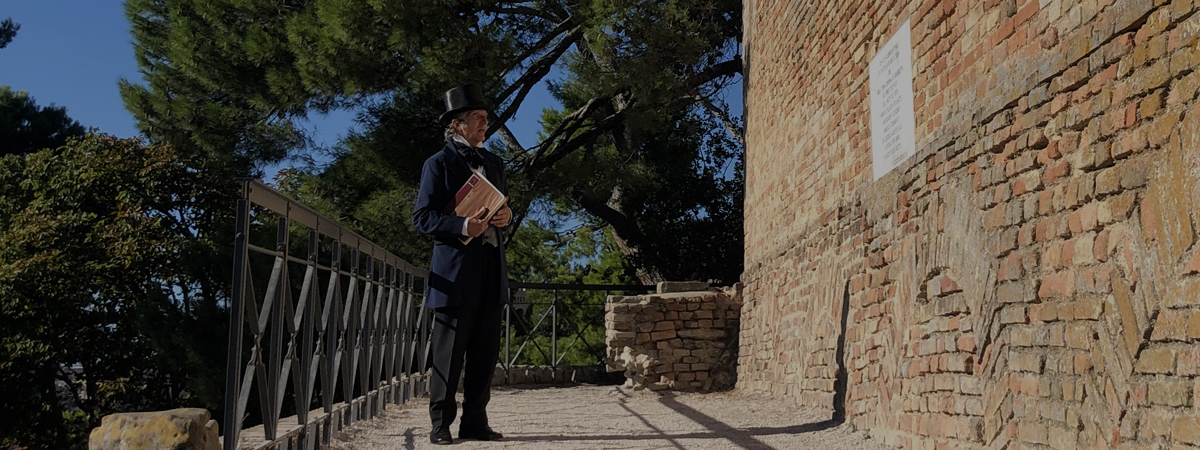LORENZO LOTTO
The life
Lorenzo Lotto’s life in reference to his presence in the region of Marche
1480 Lorenzo Lotto was born in Venice
1506 Commissioning of the large Polyptych of San Domenico for the Dominican church of the city of Recanati (Villa Colloredo Mels). The commissioning contract mentions some of the works already created by the painter and visible in Recanati (the place is not indicated, but it is clear from the context of the sentence) in his “adolescence”.
(Super supplicatione prioris fratrum S. Dominici petentis subsidium pro cona magni preti per magistrum L. Lotum Venetum construenda juxta designum ostensum et de melioribus picturis que sinte este que inspiciuntur made in iuventute vel potius adolescence). Among the paintings from this period in the city, there is a panel dated, albeit with many doubts, to his initial production.
This is the Holy Family preserved in the Diocesan Museum.
1506-1508 Lotto is in Recanati to execute the Polyptych of St. Dominic. After his success in Treviso between the turn of the century and 1506 (in 1505 he is called a “pictor celeberrimus”) and from a sequence of sacred, allegorical, and astonishing portrait paintings that show a constant updating on the best lagoon innovations, in the summer of 1506 he was in the Marche region to sign the contract for the polyptych of San Domenico, delivered in 1508. The commitment to the monumental polyptych, however, had to keep him in Recanati for a long time, where he may have produced a few minor works, so far, however, not identified with critical agreement. The document of 1506 mentions that he was then assisted by a pupil named Domenico, perhaps the young Domenico Capriolo, a native of Treviso born around 1494 to whom the predella compartment depicting the Sermon in the Kunsthistorisches Museum in Vienna could be traced.
1510-1512 Lorenzo Lotto is present in Recanati on April 14, 1510.
In 1511:
- on Sept. 12 the men of the church S. Maria in Castelnuovo di Recanati solicit the promised contribution to the municipality for the Transfiguration-an indication that the work was in progress or could be finished soon;
- on October 27 Lotto is in Jesi to sign the contract for the Deposition, which he will deliver in 1512.
1512 was a year in which Lotto was still present in the area:
on April 30, 1512 in his will Gian Cristoforo Romano, from December 17, 1510 in Loreto as sculptor, from June 5, 1511 Architect of the Fabbrica di Loreto until his death on May 31, 1512, leaves to the magistrum Laurentium venetum and two other painters drawings and waxes.
- October 5, 1512 shows a payment to Lotto for two paintings cum figures made from the treasury of Sigismondo Gonzaga, from 1509 Legate of the Marche and residing between Mantua and Macerata: one of the two may be Judith with the head of Holofernes.
To these years date: the Transfiguration and the small painting with St. James the Pilgrim (Villa Colloredo Mels); the fresco depicting St. Vincent Ferrer in Gloryforthe Church of St. Dominic (now located in the Cathedral); and the panel with the Deposition of Christ in the Sepulcher (Jesi, Pinacoteca Civica, 1512). Outlined with these works is the Venetian’s stylistic turn toward the courtly and theocratic classicism deployed by Raphael in the Stanze della Segnatura.
1513 From this year Lorenzo Lotto resides in Bergamo and then from late 1525 in Venice. He continued to send works to the Marches: the Madonna and Child with Saints Joseph and Jerome (1526), the panels depicting the Angel Announcingand the Virgin Annunciate, formerly part of a triptych whose central compartment is lost, the grandiose St. Lucia Altarpiece(1532), the Visitation, all works preserved in the splendid Rococo setting of Palazzo Pianetti in Jesi, home of the Pinacoteca Civica.
1529 Around this year dates the monumental Crucifixion of S. Maria in Telusiano di Monte San Giusto (MC) commissioned by the powerful prothonotary apostolic Nicolò Bonafede, a native of Monte San Giusto, who paid for the work 100 florins to which he added a supply of excellent oil from Ascoli, portrayed in the painting. The large altarpiece, equipped with the magnificent original frame, was begun and largely executed in Venice, while its completion had to take place in Monte S. Giusto, at least for the part relating to the portrait of the commissioner depicted with the habit kneeling at lower left
1531 For Castelplanio, a small castle near Jesi, the artist probably executed a unitary polyptych that has been dispersed over time: one of the surviving panels depicts St. Christopher, the other represents St. Sebastian , and both are preserved in the Gemaldegalerie in Berlin.
1534 – 1539 As early as 1534 Lotto is reported to have lived in Ancona, as attested by a document dated October 24. To this year dates a Sacra Contemplazione at the Uffizi, signed and dated 1534, of which there is a later autograph replica at the Courtauld Institute in London. In 1535 he executed the Madonna in Glory and Saints formerly in the church of S. Agostino in Fermo and now in a private collection in Rome. Between 1535 and 1536 the artist executed for the Holy House of Loreto the painting of St. Christopher between St. Sebastian and St. Roch (Pinacoteca di Palazzo Apostolico di Loreto). In 1538 Lotto executed for Ancona the great Madonna and Saints, preserved in the Pinacoteca Civica, next to one of the masterpieces of early Titian, the Gozzi Altarpiece of 1521, and also in Ancona he left one of his last works, the “Assumption” of San Francesco alle Scale of 1550 (read more below), also not far from another work of Titian’s extreme maturity, the “Crucifixion” of the Church of San Domenico. It is in the Marches, then, paradoxically, more than in Venice, that the work of the two artists, so different from each other but of equal monumental stature, is interwoven in a unique and evocative itinerary through Ancona’s museums and churches.
1539 Lorenzo Lotto executed one of his last monumental altarpieces, Our Lady of the Rosary with the Fifteen Mysteriesof Cingoli (Pinacoteca, now back in the church of S. Domenico); it is a canvas commissioned by the local Confraternity of the Rosary, which was based in the church of San Domenico. The work once seen is unforgettable: for the playful detail of the little angels in the foreground throwing rose petals taken from a wicker basket, at the same time an object of daily use and a document of this centuries-old craft tradition in the area; for the fascinating figure of Mary Magdalene, richly attired, and perhaps identifiable, as local tradition has it, with Sperandia Simonetti, a noblewoman from Cingoli. In 1539 he probably lived between Ancona and Macerata, from where on October 14 he wrote to the Priors of Cingoli to request payment for the Madonna del Rosario.
1540 After relentless movement to many places in the region, Lotto returned to Venice in 1540. He was in his 60s and for the third time tried to establish himself in his hometown, after his early beginnings and his return from Bergamo in the winter of 1525. The Dominican friars of Santi Giovanni e Paolo commissioned him to paint a large altarpiece, on which he worked for two years. Precisely in 1540 he began to record with regularity almost every event in his working life in the so-called Book of Miscellaneous Expenses, an account book that he updated to the last kept at the Holy House of Loreto. One of the earliest works witnessed in the Book of Miscellaneous Expenses is the portrait of the prothonotary of Ancona Giovanni Maria Pizoni, from a private collection in Milan.
1548 He executed the Madonna in Glory with Child and Saints John the Baptist, Anthony of Padua, Mary Magdalene and Joseph for the Archpriest’s Church of Santa Maria di Mogliano (MC), which still has its splendid original frame. As it is written in Lotto’s Book of Miscellaneous Expenses , it was commissioned in 1547 by Jacomo Boninfante, Mayor of the Church of S. Maria. For the work Lotto collected 130 scudi d’oro, which was also to cover the cost of the colors and the workmanship of the wooden frame.
1549 After finding that he could no longer find work in the Veneto region (where, in addition to Titian, masters such as Tintoretto, Schiavone Bonifacio Veronese, Bernardino Licinio, and Paris Bordon were working hard), he decided to return to the Marche region in 1549.
1550 Lotto is in Ancona between 1550 (operative for execution at the church of S. Francesco alle Scale of theAssumption) and 1554, then moving to the end of his days to the Holy House of Loreto. Other commissions for churches in the city emerge from the Book of Miscellaneous Expenses, such as that for the church of S. Anna dei Greci and for that of S. Maria di Posatora: of this there are two panels depicting St. Sebastian (in a private collection) and St. Rocco (Urbino, Galleria Nazionale delle Marche). He also executed several portraits for private citizens. Between 1550 and 1551 Lotto set up a lotterianellaLoggia dei Mercanti in Ancona to try to sell paintings and cartoons for the inlays of the choir of S. Maria Maggiore in Bergamo.
1552 – 1556/ 1557 The artist decided to settle in Loreto to spend the last years of his life, which from a religious point of view can be considered between adherence to the Catholic faith and even direct knowledge of Lutheran principles: many of Lotto’s friends were in fact involved in trials by the Inquisition Tribunal. The works of his extreme maturity are preserved in the Pinacoteca del Palazzo Apostolico in Loreto, the place where Lorenzo Lotto died between 1556 and 1557. His last work is considered the poignant and disturbing Presentation in the Temple.
Source: Lorenzo Lotto, general catalog of paintings edited by E. M. Dal Pozzolo with the collaboration of Raffaella Poltronieri and Valentina Castegnaro and Marta Paraventi Skira 2021

